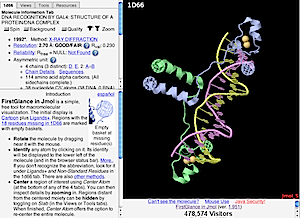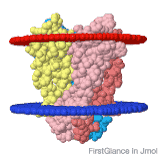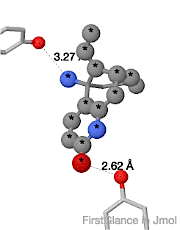FirstGlance in Jmol: Difference between revisions
Eric Martz (talk | contribs) No edit summary |
Eric Martz (talk | contribs) |
||
| (13 intermediate revisions by the same user not shown) | |||
| Line 1: | Line 1: | ||
[[Image:Firstglance-resource-link.png|left]] | [[Image:Firstglance-resource-link.png|left]] | ||
[[Image:Fgij window2.png|frame|Screenshot of [http://firstglance.jmol.org FirstGlance in Jmol]]] | [[Image:Fgij window2.png|frame|Screenshot of [http://firstglance.jmol.org FirstGlance in Jmol]]] | ||
Every molecule in '''Proteopedia''' can be explored in FirstGlance in Jmol, using the link beneath the molecule (on pages titled with a [[PDB code]], such as [[1d66]]). | Every molecule in '''Proteopedia''' can be explored in FirstGlance in Jmol, using the link beneath the molecule (on pages titled with a [[PDB code]], such as [[1d66]]). FirstGlance has many [http://firstglance.jmol.org/whatis.htm#unique unique and powerful capabilities] not found in other viewers such as [[PyMOL]], [[ChimeraX]], or [[Mol*]] offered by the [[wwPDB]]. | ||
When you go directly to [http://firstglance.jmol.org FirstGlance in Jmol], you can enter any [[PDB code]], or upload a [[PDB file]] from your computer, such as a [[Practical Guide to Homology Modeling|homology model]]. | When you go directly to [http://firstglance.jmol.org FirstGlance in Jmol], you can enter any [[PDB code]], or upload a [[PDB file]] from your computer, such as a prediction by [[AlphaFold]] or a [[Practical Guide to Homology Modeling|homology model]]. | ||
FirstGlance in Jmol ([http://firstglance.jmol.org firstglance.jmol.org]) is a free, open-source, macromolecular visualization software package that operates on-line in a web browser. It uses free open-source [[ | FirstGlance in Jmol provides an easy interface to make a Powerpoint-ready animation from any of its molecular views. Examples: [http://tinyurl.com/movingmolecules tinyurl.com/movingmolecules]. FirstGlance in Jmol version 4.0 was released August 15, 2022, with new capability to [[FirstGlance/Virus Capsids and Other Large Assemblies|automatically construct large assemblies such as virus capsids]]. | ||
FirstGlance in Jmol ([http://firstglance.jmol.org firstglance.jmol.org]) is a free, open-source, macromolecular visualization software package that operates on-line in a web browser. It uses free open-source [[JSmol]], as does Proteopedia. It works in the most popular web browsers, and MS Windows, Apple Mac OS X, and linux. It operates from menus and forms -- no familiarity with the Jmol command scripting language is required. Tooltips are everywhere, and explanatory help, with color keys and examples for comparison, appear automatically for each view. | |||
In order to be as easy as possible to use, FirstGlance in Jmol does not provide tools to customize the molecular view, but rather offers a series of "canned" views that reveal the major structural features of the molecule, such as composition (protein, DNA, RNA, ligand and solvent) secondary structure, amino and carboxy termini, hydrophobic and polar surfaces, surface charges, salt bridges and cation-pi interactions. Any moiety can be hidden by clicking on it in ''Hide'' mode. Any residue or sequence number can be found/located in the ''Find'' dialog. | In order to be as easy as possible to use, FirstGlance in Jmol does not provide tools to customize the molecular view, but rather offers a series of "canned" views that reveal the major structural features of the molecule, such as composition (protein, DNA, RNA, ligand and solvent) secondary structure, amino and carboxy termini, hydrophobic and polar surfaces, surface charges, salt bridges and cation-pi interactions. Any moiety can be hidden by clicking on it in ''Hide'' mode. Any residue or sequence number can be found/located in the ''Find'' dialog. | ||
| Line 11: | Line 13: | ||
Non-covalent interactions ([[Hydrogen bonds|hydrogen bonds]], salt bridges, hydrophobic interactions) with any designated target moiety are displayed automatically in a powerful ''Contacts'' dialog in FirstGlance in Jmol. The target moiety (a chain, a range of residues in a chain, a residue or group, or a single atom) is selected beforehand by clicking on it. | Non-covalent interactions ([[Hydrogen bonds|hydrogen bonds]], salt bridges, hydrophobic interactions) with any designated target moiety are displayed automatically in a powerful ''Contacts'' dialog in FirstGlance in Jmol. The target moiety (a chain, a range of residues in a chain, a residue or group, or a single atom) is selected beforehand by clicking on it. | ||
<table class="wikitable" align="left" width="300"><tr><td> | |||
[[Image:1r3j-opm-160px-48colors.gif]] | |||
</td><td> | |||
Potassium channel ([[1r3j]]) | |||
showing membrane | |||
surface planes. | |||
From [http://opm.phar.umich.edu/ OPM]. | |||
</td></tr></table> | |||
<table class="wikitable" align="right" width="300"><tr><td> | |||
[[Image:1gpk-contacts-180px-48colors.gif]] | |||
</td><td> | |||
Anti-Alzheimer's drug interaction with acetylcholinesterase ([[1gpk]] cf. [[1vot]]). | |||
</td></tr></table> | |||
Any molecular scene obtained in FirstGlance in Jmol can be saved, with just a few clicks, as a high-resolution static image, or as a presentation-ready animation. [http://tinyurl.com/movingmolecules Examples of molecular animations] made with FirstGlance, in slides. | Any molecular scene obtained in FirstGlance in Jmol can be saved, with just a few clicks, as a high-resolution static image, or as a presentation-ready animation. [http://tinyurl.com/movingmolecules Examples of molecular animations] made with FirstGlance, in slides. | ||
Any molecular view obtained in FirstGlance in Jmol can become a scene attached to a green link in Proteopedia: please see [[Help:Copying FirstGlance Scenes into Proteopedia]]. | Any molecular view obtained in FirstGlance in Jmol can become a scene attached to a green link in Proteopedia: please see [[Help:Copying FirstGlance Scenes into Proteopedia]]. | ||
{{Clear}} | |||
==Java Not Needed== | ==Java Not Needed== | ||
Following the example set by Proteopedia in early 2014, beginning with FirstGlance version 2.00 (released late April, 2014), FirstGlance in Jmol works without Java | Following the example set by Proteopedia in early 2014, beginning with FirstGlance version 2.00 (released late April, 2014), FirstGlance in Jmol uses the Javascript version of Jmol, ''JSmol'', and thus works without Java (see [[Jmol#Jmol_Has_Four_Forms| four forms of Jmol]]). | ||
==Adoptions== | ==Adoptions== | ||
| Line 24: | Line 40: | ||
==See Also== | ==See Also== | ||
*[[FirstGlance/Index]] lists related resources within Proteopedia and elsewhere. | |||
* [[Teaching_Strategies_Using_Proteopedia#Molecular_Structure:_FirstGlance_in_Jmol|Teaching with FirstGlance in Jmol]]. | * [[Teaching_Strategies_Using_Proteopedia#Molecular_Structure:_FirstGlance_in_Jmol|Teaching with FirstGlance in Jmol]]. | ||
* [[Help:Copying FirstGlance Scenes into Proteopedia]]. | * [[Help:Copying FirstGlance Scenes into Proteopedia]]. | ||
Latest revision as of 20:36, 23 October 2024


Every molecule in Proteopedia can be explored in FirstGlance in Jmol, using the link beneath the molecule (on pages titled with a PDB code, such as 1d66). FirstGlance has many unique and powerful capabilities not found in other viewers such as PyMOL, ChimeraX, or Mol* offered by the wwPDB.
When you go directly to FirstGlance in Jmol, you can enter any PDB code, or upload a PDB file from your computer, such as a prediction by AlphaFold or a homology model.
FirstGlance in Jmol provides an easy interface to make a Powerpoint-ready animation from any of its molecular views. Examples: tinyurl.com/movingmolecules. FirstGlance in Jmol version 4.0 was released August 15, 2022, with new capability to automatically construct large assemblies such as virus capsids.
FirstGlance in Jmol (firstglance.jmol.org) is a free, open-source, macromolecular visualization software package that operates on-line in a web browser. It uses free open-source JSmol, as does Proteopedia. It works in the most popular web browsers, and MS Windows, Apple Mac OS X, and linux. It operates from menus and forms -- no familiarity with the Jmol command scripting language is required. Tooltips are everywhere, and explanatory help, with color keys and examples for comparison, appear automatically for each view.
In order to be as easy as possible to use, FirstGlance in Jmol does not provide tools to customize the molecular view, but rather offers a series of "canned" views that reveal the major structural features of the molecule, such as composition (protein, DNA, RNA, ligand and solvent) secondary structure, amino and carboxy termini, hydrophobic and polar surfaces, surface charges, salt bridges and cation-pi interactions. Any moiety can be hidden by clicking on it in Hide mode. Any residue or sequence number can be found/located in the Find dialog.
Non-covalent interactions (hydrogen bonds, salt bridges, hydrophobic interactions) with any designated target moiety are displayed automatically in a powerful Contacts dialog in FirstGlance in Jmol. The target moiety (a chain, a range of residues in a chain, a residue or group, or a single atom) is selected beforehand by clicking on it.
|
Potassium channel (1r3j) showing membrane surface planes. From OPM. |
|
Anti-Alzheimer's drug interaction with acetylcholinesterase (1gpk cf. 1vot). |
Any molecular scene obtained in FirstGlance in Jmol can be saved, with just a few clicks, as a high-resolution static image, or as a presentation-ready animation. Examples of molecular animations made with FirstGlance, in slides.
Any molecular view obtained in FirstGlance in Jmol can become a scene attached to a green link in Proteopedia: please see Help:Copying FirstGlance Scenes into Proteopedia.
Java Not NeededJava Not Needed
Following the example set by Proteopedia in early 2014, beginning with FirstGlance version 2.00 (released late April, 2014), FirstGlance in Jmol uses the Javascript version of Jmol, JSmol, and thus works without Java (see four forms of Jmol).
AdoptionsAdoptions
3D View or "3D" links to FirstGlance in Jmol were offered in every article reporting a new structure in Nature Structural and Molecular Biology from February, 2006 through December, 2018, and in Nature from November, 2007 through March, 2018. It has also been offered as a visualization option by other journals and numerous structural bioinformatics servers and databases, including the journal Protein Science, several other Nature "spinoff" journals, Proteopedia, ConSurf, the Protein Data Bank, Orientations of Proteins in Membranes, and others.
See AlsoSee Also
- FirstGlance/Index lists related resources within Proteopedia and elsewhere.
- Teaching with FirstGlance in Jmol.
- Help:Copying FirstGlance Scenes into Proteopedia.
- What is FirstGlance in Jmol? (Includes comparisons with other software packages.)
- All About FirstGlance in Jmol.
- Jmol
- Molecular modeling and visualization software
- Protein Explorer.

